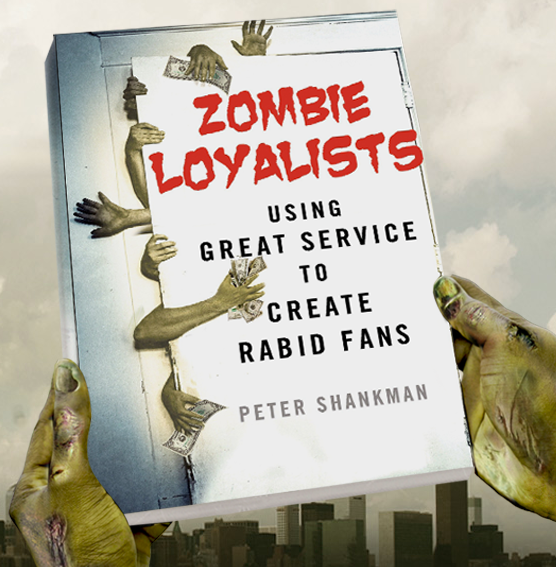The truth about customer service: forget about delighting and focus on the basics

Posted by Karen Hesse
October 1st, 2015
It’s time for companies to stop trying to delight their customers and focus instead on making their customer experience more ‘effortless’.
This idea may run contrary to going the extra mile to please your customers, but when it’s coming from Mikkel Svane, CEO of Zen Desk, the sales and marketing world sits up to listen.
Zen Desk, a tech company with a market cap of $1.88b is acknowledged for “disrupting the market with its online customer service ticketing system”. But as Svane himself tells his audience at Inbound - one of the biggest sales and marketing events in the world - in Boston, the market is already disrupted.
Like marketers all over the globe, the 14,000 sales and marketing professionals gathered at the conference are grappling with an era of empowered customers in a referral economy where the rules of engagement have fundamentally changed.
So we can expect to be hearing a lot more about Customer Experience, or CX in the coming years.
The era of customer experience
Peter Shankman, best-selling author of Zombie Loyalists – using great customer service to create rabid fans, would take it even further.
“The next 50 years of the economy are going to be run by the customer experience. Advertising and marketing will be important but nowhere near as important as they are today,” says Shankman. He argues that in the next 12-24 months the concept of friending, liking, and following will disappear as the referral economy really takes hold.
Companies need to “stop chasing likes and start doing things that are likeable,” he says.
But the good news for companies struggling with turning customers into promoters, or ‘Zombie Loyalists’, is that it doesn’t have to be about lavish PR stunts and promising lots of freebies.

“As a society, whether we’re buying a burger or renting a car, we expect in any customer service interaction to be treated like crap. So companies don’t need to be that great, just a few levels above being crap,” Shankman says.
Mikkel Svane agrees that it’s really about getting the basics right and designing CX into the business model.
“Companies should focus on making service easier, not more delightful. They can do this by reducing the amount of work required of customers to get their issues solved.”
Creating and embedding a customer experience culture in companies and empowering staff to deliver will be critical for business that wants tomake the most of the ‘referral economy,” Svane says. One of the big trends is the move from a transactional sales model to a subscription based model like Netflix, Dropbox, and Uber where it’s the convenience of using these services that makes customers come back.
And Svane has the proof to back it up: “96% of customers that had high effort experiences reported being disloyal while just 9% of customer with low effort experiences were disloyal. Delighting customers just doesn’t work. There’s not a big difference in loyalty if we meet expectations and exceed the expectations.”
Companies like Amazon and Airbnb are focused on the lifetime value of the customer relationship. As Svane puts it “it’s not the advertising reach that defines the success of these companies, it’s their ability to reach customers early on and to turn them into evangelists or promoters. No one started using Uber because they saw an ad for it. They heard about it from their friends”.
Getting the customer service basics right
But for many companies even getting the customer service basics right is a struggle and the C Suite is often part of the problem. “88% of all CEOs said their customer service was the best, but only 8% of customers and clients of the same companies agreed,” Peter Shanmkan says.
Mikkel Svane argues that many stories promoted as examples of great customer service are really just marketing ploys and are ultimately not effective in retaining customers. He gives the example of an airline that delivered pizzas to a grounded flight: “None of these customers want to sit on a plane eating pizza. Whatever the airline does they are going to hate them if they don’t get them home on time.”
That’s not to say that it’s not important for a brand to have a personality. In the referral economy customers want to feel that they are dealing with real people. But for this to really work companies need to empower their staff to act as humans.
One of the big problems companies have when it comes to customer service is that they are ‘obsessed with authority”. Often the staff dealing with the customer can’t go off the script, says Seth Godin, Best-selling author of Permission Marketing.
When customer service staff do go off script it’s so unusual that it still gets media attention. Netflix’s customer service went viral when a staff member dealing with an enquiry realised the customer was a Star Trek fan and responded as if he was a member of the crew.
But the culture of the company needs to give staff permission to take this kind of initiative.
“Hire people who like people and who like to do nice things. It has to be a culture. If it’s not built in to the business people will be afraid to take responsibility,” Godin says.
While there’s a cost to finessing the customer service model including investing in technology to give a clear view of the customer journey and touch points, Shankman also points out that 99% of customer service is free.
“Every time someone comes to your business they are coming to you because they have a problem that you can solve.” Most businesses can help customers with their experience and knowledge. So the question really should be: “What can you do to strategically help your customers with the extras you already have?”
And one final thought from Inbound Boston? When you do something nice for your customer, never look for anything in return. If you’ve done your job well the referral economy will look after the rest.
How Uber builds CX into the design
Online transportation network Uber has revolutionised the customer experience by building CX into its design. When a customer hires a taxi or finds a car-share through the service, they cannot complete the transaction until they rate the driver.
And the driver also has to rate the passenger. If service drops below a particular level Uber staff make a call to find out why. This process ensures the customer is helping to regulate the service levels to guarantee delivery across 1,000s of transport providers and customers.
While customer engagement might currently look like an add-on for big companies like Uber, it will soon become a necessity. After all, the customer is always right!
Want to create a customer experience strategy of your own?
If you want to make customer experience an important part of your brand or product, get in touch and we’ll talk you through it. In the meantime, follow us on Facebook, Twitter, and Pinterest to keep up with all things content and digital media.
P.S. this post was written by 256 CEO, Karen Hesse, and originally appeared in the Sunday Business Post.


Previous Post
Blogger outreach – what is it and how to influence the influencers?
Next Post

Social media outreach – how to get your content out there
Subscribe Here
You may also like...
Lisa Sills | Jul 3, 2018
Karen Hesse | Oct 1, 2015
256 | Mar 5, 2015






